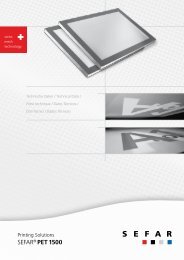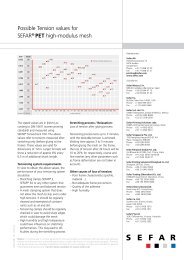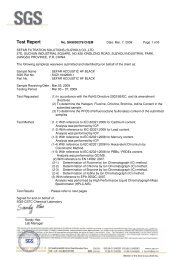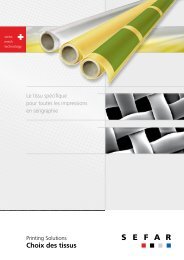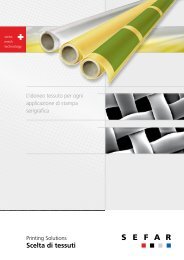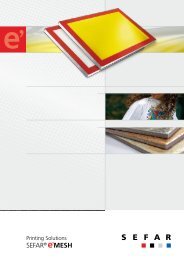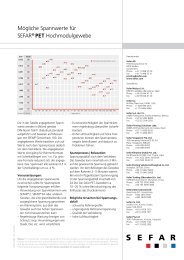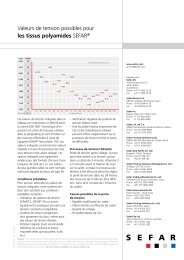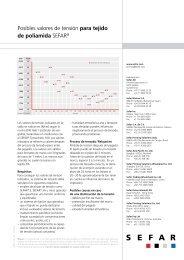Architecture LightFrame – Modular fabric ceilings - SEFAR
Architecture LightFrame – Modular fabric ceilings - SEFAR
Architecture LightFrame – Modular fabric ceilings - SEFAR
Create successful ePaper yourself
Turn your PDF publications into a flip-book with our unique Google optimized e-Paper software.
Acoustic <strong>fabric</strong>s<br />
Building trends and good acoustics<br />
Construction using <strong>fabric</strong>s has many<br />
advantages. In addition to the benefits<br />
of being both light in weight and<br />
aesthetically pleasing, they also satisfy<br />
an increasing demand for materials<br />
providing light-technical and acoustic<br />
solutions.<br />
Compared with the traditional, hard<br />
building products like concrete, glass<br />
and metal, <strong>SEFAR</strong> ®<strong>Architecture</strong> Fabrics<br />
are light, soft and reminiscent of<br />
organic materials. The impressions they<br />
create lead to some surprising and<br />
innovative designs. As well as the<br />
temperature of a room, spatial<br />
acoustics also strongly influence the<br />
working atmosphere and efficiency in<br />
the workplace. A good acoustic<br />
solution is always aligned with the<br />
functional purpose of that room.<br />
With <strong>SEFAR</strong> ®<strong>Architecture</strong> Fabrics you<br />
can target room acoustics directly.<br />
Different types of <strong>fabric</strong>s present new<br />
possibilities.<br />
8<br />
Acoustic pressure<br />
Direct sound<br />
Early reflections<br />
Reverberation<br />
Time<br />
Direct sound<br />
Directly received sound without noise reflection<br />
Reflection<br />
Noise is reverted back<br />
Reverberation<br />
Sequence of repeated noise reflections, indirect<br />
reverberation<br />
What is reverberation?<br />
Reverberation is the physical vibration<br />
of particles in solid, liquid or gaseous<br />
bodies, which is spread in waves. This<br />
physical oscillation is not only audible<br />
but at times also visible and perceptible.<br />
In air molecules, these vibrations cause<br />
pressure variations in outwardly<br />
expanding wave formations. These<br />
fluctuations in the air overlap with the<br />
atmospheric pressure and are known<br />
as reverberation.<br />
In the construction industry, the<br />
relevant properties of reverberation<br />
are pitch and its volume. As explained<br />
above, reverberation is a wave<br />
formation and the number of these<br />
waves per time unit is its frequency.<br />
Measured in Hertz (Hz), where one<br />
wave per second is 1 Hz. Many waves<br />
per second means a higher frequency<br />
and a higher pitch. Fewer waves per<br />
second means a lower frequency and<br />
therefore a lower pitch. If the wave is<br />
constant, this is known as a “sine<br />
tone“ but if the wave is irregular, we<br />
speak of noise.<br />
With/without<br />
translucent ETFE foil<br />
With/without<br />
translucent ETFE foil<br />
Sound<br />
Daylight<br />
Sound<br />
Sound absorption<br />
Here we are talking about the reduction<br />
of reverberation within a space. Note:<br />
Noise generators and sound receivers<br />
are situated in a spatial area. Suspended<br />
ceiling systems such as the Lightframe<br />
system absorb reverberation, thus<br />
reducing the noise within that space.<br />
The absorption characteristics of a ceiling<br />
are influenced by:<br />
<strong>–</strong> The nature and composition of the<br />
sound absorption surface<br />
<strong>–</strong> Flow resistance<br />
<strong>–</strong> Thickness/size of the sound absorption<br />
surface<br />
<strong>–</strong> Free cross-section/perforation of the<br />
<strong>fabric</strong><br />
<strong>–</strong> Texture of the ceiling cavity<br />
With sound absorption, mechanical<br />
energy (sound) is converted into heat<br />
(energy). This happens essentially by<br />
means of friction processes in the absorption<br />
material. The unit of measurement<br />
for sound absorption is the sound<br />
absorption coefficient which shows the<br />
relationship between the amount of<br />
sound energy falling on a surface and<br />
that leaving it. This figure lies between<br />
0 (completely reflected) and 1 (completely<br />
absorbed). Absorbers work in different<br />
ways but there is a physical interdependency<br />
between the material’s properties,<br />
the mechanical structure, the absorption<br />
coefficient and the wave frequency.<br />
Non-transparent wall/ceiling<br />
(e.g. concrete, plasterboard)<br />
Artificial light source<br />
between wall/ceiling<br />
Translucent<br />
<strong>fabric</strong> surface<br />
Transparent ceiling/roof<br />
(e.g. glass)<br />
Artificial light<br />
between ceiling/roof<br />
Translucent<br />
<strong>fabric</strong> surface







